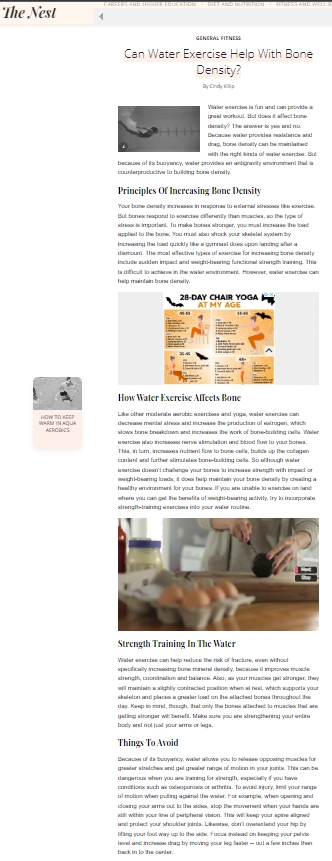
Article published in Woman: The Nest
Water exercise is fun and can provide a great workout. But does it affect bone density? The answer is yes and no. Because water provides resistance and drag, bone density can be maintained with the right kinds of water exercise. But because of its buoyancy, water provides an antigravity environment that is counterproductive to building bone density.
Principles Of Increasing Bone Density
Your bone density increases in response to external stresses like exercise. But bones respond to exercise differently than muscles, so the type of stress is important. To make bones stronger, you must increase the load applied to the bone. You must also shock your skeletal system by increasing the load quickly like a gymnast does upon landing after a dismount. Research shows that the most effective types of exercise for increasing bone density include sudden impact and weight-bearing strength training with variations of direction and gradual increases of loading, for example, through added weight or bands. This is difficult to achieve in the water environment. However, the right kind of water exercise can increase strength and help maintain bone density. If you are new to exercise, this may result in some initial improvement in bone strength.
How Water Exercise Affects Bone
Like other aerobic exercises and yoga, water exercise can decrease mental stress and increase the production of estrogen, which slows bone breakdown and increases the work of bone-building cells. Water exercise also increases nerve stimulation and blood flow to your bones. This, in turn, increases nutrient flow to bone cells, builds up the collagen content and further stimulates bone-building cells. So although water exercise doesn’t challenge your bones to increase strength with impact or weight-bearing loads, it does help maintain your bone density by creating a healthy environment for your bones. If you are unable to exercise on land where you can get the benefits of weight-bearing activity, try to incorporate strength-training exercises into your water routine.
Strength Training In The Water
Water exercise can help reduce the risk of fracture, even without specifically increasing bone mineral density, because it improves muscle strength, coordination and balance. Also, as your muscles get stronger, they will maintain a slightly contracted position when at rest, which supports your skeleton and places a greater load on the attached bones throughout the day. Keep in mind, though, that only the bones attached to muscles that are getting stronger will benefit. Make sure you are strengthening your entire body and not just your arms or legs.
Things To Avoid
Because of its buoyancy, water allows you to release opposing muscles for greater stretches and get greater range of motion in your joints. This can be dangerous when you are training for strength, especially if you have conditions such as osteoporosis or arthritis. To avoid injury, limit your range of motion when pulling against the water. For example, when opening and closing your arms out to the sides, stop the movement when your hands are still within your line of peripheral vision. This will keep your spine aligned and protect your shoulder joints. Likewise, don’t overextend your hip by lifting your foot way up to the side. Focus instead on keeping your pelvis level and increase drag by moving your leg faster — out a few inches then back in to the center.
To read more about how to strength train in the water, see my article, Is Water Aerobics As Good As Weightlifting? Also check out A List of Different Water Aerobics Exercises to learn how to do some classic water aerobic exercises.
References
- Oregon State University: Water Exercise Effects on Bone Density and Fall Risk in Postmenopausal Women
- The Aging Spine: Water Exercise and Treatment Principles; Martha White and H.B. Cotler
- The Journal of Sports Medicine and Physical Fitness: The Effect of a Water Exercise Program on Bone Density of Postmenopausal Women
- The effect of aquatic exercise on bone mineral density in older adults. A systematic review and meta-analysis; Front. Physiol., 12 March 2023, Sec. Exercise Physiology, Volume 14 – 2023
Writer Bio
Cindy Killip is a medical exercise specialist, health coach, author and speaker who has been teaching and writing about exercise and wellness since 1989. She authored the book Living the BONES Lifestyle: A Practical Guide to Conquering the Fear of Osteoporosis [2012]. Killip received certifications as a medical exercise specialist, health coach, personal trainer, and group fitness instructor through the American Council on Exercise, and degrees in communications and sociology from Trinity University with a focus on pre-med and exercise science/lifetime fitness. She studied exercise physiology at the University of New Mexico graduate school.

Article is published on Woman: The Nest at http://woman.thenest.com/can-water-exercise-bone-density-17704.htm



